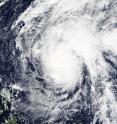NASA's Terra satellite sees Typhoon In-fa stretching
NASA's Terra satellite flew over Typhoon In-fa on Nov. 23 and imagery showed the storm had become elongated to the northeast. On Nov. 23 at 02:00 UTC (Nov. 22 at 9 p.m. EST) the Moderate Resolution Imaging Spectroradiometer or MODIS instrument aboard NASA's Terra satellite captured an image of Typhoon In-fa in the Pacific Ocean. In-fa's cloud-filled eye was surrounded by powerful thunderstorms. A large band of thunderstorms were wrapping into the low-level center in the northeastern quadrant, and stretching east.
Forecasters at the Joint Typhoon Warning Center noted that the system continues to be elongated to the northeast along the leading edge of an approaching mid-Latitude trough (elongated area of low pressure).
On Nov. 23 at 1500 UTC (10 a.m. EST), Typhoon In-fa had maximum sustained winds near 90 knots (103.6 mph/ 166.7 kph). Typhoon-force winds only extend nautical 25 miles (28.7 miles/46.3 km) from the center. It was centered near 16.9 north latitude and 131.3 east longitude, about 734 nautical miles (844.7 miles/1,359 km) southwest of Iwo To, Japan. In-fa was moving to the north-northwest at 4 knots (4.6 mph/7.4 kph) and is expected to curve to the northeast.
Environmental conditions are expected to continue to deteriorate as vertical wind shear rapidly increases due to the strong westerly winds from the approaching trough.
The Joint Typhoon Warning Center expects In-fa to weaken over the next couple of days and become an extra-tropical storm. In-fa is forecast to approach the island of Iwo To, Japan on Nov. 26 and move in a northeasterly direction.
Source: NASA/Goddard Space Flight Center
Articles on the same topic
- NASA's GPM finds extreme rainfall in Typhoon In-faTue, 24 Nov 2015, 16:04:47 UTC
- NASA eyes Tropical Cyclone Annabelle in Southern Indian OceanTue, 24 Nov 2015, 16:04:01 UTC
- NASA sees In-Fa get better organized, re-strengthenTue, 24 Nov 2015, 16:03:50 UTC
Other sources
- GPM finds extreme rainfall in Typhoon In-fafrom PhysorgTue, 24 Nov 2015, 16:30:34 UTC
- Terra satellite sees Typhoon In-fa stretchingfrom PhysorgMon, 23 Nov 2015, 21:30:27 UTC
- NASA analyzes Tropical Storm In-fa's winds, rainfrom PhysorgThu, 19 Nov 2015, 16:10:18 UTC
- NASA sees In-fa become a Typhoon near Micronesiafrom PhysorgThu, 19 Nov 2015, 10:11:48 UTC
